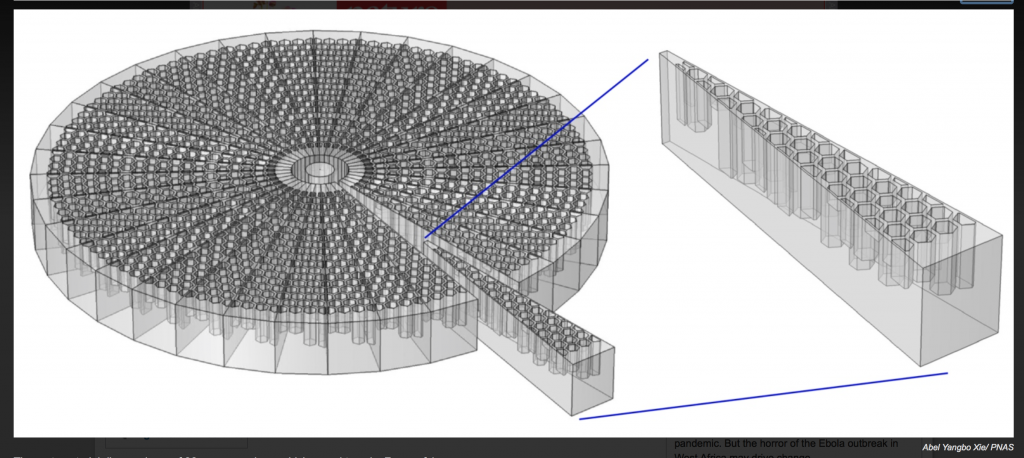If you have ever tried to give vocal directions to your smartphone while amidst a group of voices, you know how hard it is for a computer to accurately select to hear a particular voice in a crowd. This difficulty is commonly referred to as “The Cocktail Party Problem” and a number of efforts, some quite comically complex, have been made at addressing this issue. Often, attempts to distinguish among voices cause inventors to rely on the use of multiple microphones that determine voice based on location in space or through the creation of algorithms that try to reduce minute differences in speech to a series of variables.
 Thus far, no particularly acceptable mechanized method for this type of differentiation has been created. But that may not be the case for much longer. This week, the Proceedings of the National Academy of Sciences published news of the invention of a small device that can pinpoint the origin of sounds without the need for complex electronics.
Thus far, no particularly acceptable mechanized method for this type of differentiation has been created. But that may not be the case for much longer. This week, the Proceedings of the National Academy of Sciences published news of the invention of a small device that can pinpoint the origin of sounds without the need for complex electronics.
To function, the device relies on the modification of sounds as they are transmitted through differently shaped spaces. In this case, 36 different channels lead inward from the perimeter of the circular object towards a microphone that is located at the center. The interior of each channel is lined with a 3D honeycomb pattern that is cut to a specific height. The height of the honeycomb and therefore the volume of air in each channel is unique. When sound passes into the device, it is modified by the available volume to attenuate at a frequency particular to the particular channel.
“By exploiting acoustic metamaterials and compressive sensing, we present here a single-sensor listening device that separates simultaneous overlapping sounds from different sources. The device with a compact array of resonant metamaterials is demonstrated to distinguish three overlapping and independent sources with 96.67% correct audio recognition,” the researchers explain in their abstract.
If you’ve ever spoken into or blown over the top of bottles filled with varying amounts of water, you’re already familiar with the way that sound is modified based on the volume into which it is projected. The same principle applies here, only instead of filling up chambers with water, the volume is modified by 3D printing different volumes that can be controlled to a high enough degree of precision that the modulation of the sound that enters indicates the direction from which the sound is coming.
 Steven Cummer, an electrical engineer at Duke University in Durham, NC and the senior author of the paper published in Proceedings, explained the way in which the device functions:
Steven Cummer, an electrical engineer at Duke University in Durham, NC and the senior author of the paper published in Proceedings, explained the way in which the device functions:
“The device is a thick plastic disk, about as wide as a pizza. Openings around the edge channel sound through 36 passages towards a microphone in the middle. Each passage modifies the sound in a subtly different way as it travels towards the centre — roughly as if an equalizer with different settings were affecting the sound in each slice.”
The team that created the device created an algorithm that indicates the origin of the sound based on those shifts in sounds, something that human ear is not sufficiently finely tuned to do. Instead, we tend to look for cues such as movement and the recognition of the vocal qualities of a person as the method for filtering sounds in a noisy room.
 This type of voice distinction capability could have myriad applications. It could be used in conjunction with speech recognition and transcription software to provide transcriptions of multiple speakers without confusing attribution, for example. Another possible application would be in the creation of assistive devices for those with hearing impairments that would allow them to read the location of the origin of particular sounds. Of course, I can also imagine this becoming a standard prop in spy movies, albeit somehow small enough to wear in the center of a carnation on the lapel of a savvy double agent.
This type of voice distinction capability could have myriad applications. It could be used in conjunction with speech recognition and transcription software to provide transcriptions of multiple speakers without confusing attribution, for example. Another possible application would be in the creation of assistive devices for those with hearing impairments that would allow them to read the location of the origin of particular sounds. Of course, I can also imagine this becoming a standard prop in spy movies, albeit somehow small enough to wear in the center of a carnation on the lapel of a savvy double agent.
At this point, the team of developers acknowledge that practical application for the device is somewhat limited by its size but, just as the computer used to be a room-sized gargantuan, the next set of developments will likely see a marked decrease in its size.
Join the discussion about this device in the 3D Printed Solution to ‘Cocktail Party Problem‘ forum thread over at 3DPB.com.
Subscribe to Our Email Newsletter
Stay up-to-date on all the latest news from the 3D printing industry and receive information and offers from third party vendors.
Print Services
Upload your 3D Models and get them printed quickly and efficiently.
You May Also Like
Consolidation in AM: How 2025 Is Shaping the Industry’s New Normal
The first half of 2025 has been marked by a clear shift in the additive manufacturing (AM) industry. Companies are no longer just focused on developing new tech by themselves....
Etsy Design Rule Change Reduces Selection of 3D Printed Goods
Online marketplace Etsy has implemented a rule change requiring all 3D printed goods on the site to be original designs. The update to the site’s Creativity Standards states, ¨Items produced using...
U.S. Congress Calls Out 3D Printing in Proposal for Commercial Reserve Manufacturing Network
Last week, the U.S. House of Representatives’ Appropriations Committee moved the FY 2026 defense bill forward to the House floor. Included in the legislation is a $131 million proposal for...
Transforming From Tourist to Native: Duro CEO Michael Corr Explains Why the Company Rebuilt its PLM Software on AI
In these early innings of the AI boom, many market analysts have expressed concern that AI spend has gotten too far ahead of the technology’s proven ability to deliver significant...
































